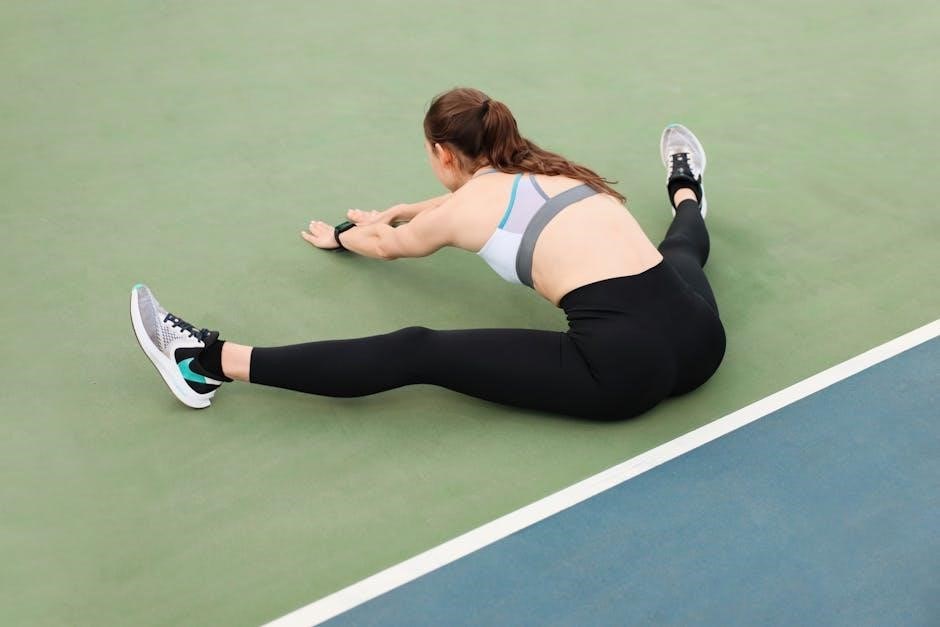Trigger thumb exercises pdf provides simple exercises to ease pain and restore movement, helping patients struggling with trigger thumb, offering relief and improved flexibility through regular practice and repetition daily.
Understanding the Importance of Exercise
Regular exercise is crucial for maintaining healthy joints and preventing further injury, as seen in trigger thumb exercises pdf.
The exercises outlined in the pdf are designed to increase flexibility and range of motion, reducing the risk of trigger thumb recurrence.
By incorporating these exercises into daily routine, individuals can improve their overall hand function and reduce pain.
The importance of exercise in trigger thumb treatment cannot be overstated, as it helps to strengthen the muscles and tendons surrounding the thumb joint.
A consistent exercise routine can also help to prevent the formation of scar tissue, which can contribute to trigger thumb development.
Additionally, exercise can help to improve circulation and reduce inflammation, promoting overall health and well-being.
By prioritizing exercise and making it a regular part of daily routine, individuals can take a proactive approach to managing trigger thumb and improving their overall quality of life.
Exercise is a vital component of trigger thumb treatment, and its importance should not be overlooked.

Types of Trigger Thumb Exercises
Trigger thumb exercises pdf includes various types, such as isometric and active exercises, to improve thumb mobility and strength, enhancing overall hand function and dexterity naturally every day.
Isometric Thumb Flexion and Extension Exercises
Isometric thumb flexion and extension exercises are essential components of trigger thumb exercises pdf, designed to improve thumb mobility and strength without moving the thumb joint.
These exercises involve contracting the muscles of the thumb without moving the joint, helping to increase flexibility and range of motion.
The trigger thumb exercises pdf provides detailed instructions on how to perform these exercises, including the correct posture, hand position, and breathing techniques.
Regular practice of isometric thumb flexion and extension exercises can help alleviate trigger thumb symptoms, such as pain and stiffness, and improve overall hand function.
By incorporating these exercises into a daily routine, individuals can experience significant improvements in thumb mobility and strength, allowing them to perform daily activities with greater ease and confidence.
The exercises can be modified to suit individual needs and abilities, making them accessible to a wide range of people.
Overall, isometric thumb flexion and extension exercises are a valuable addition to any trigger thumb exercise routine.

Benefits of Regular Exercise for Trigger Thumb
Regular exercise reduces trigger thumb pain and stiffness, improving overall hand function and mobility with trigger thumb exercises pdf daily.
Increasing Flexibility and Range of Motion
Trigger thumb exercises pdf offers various exercises to increase flexibility and range of motion, helping patients to regain control and movement in their thumb and fingers. The exercises provided in the pdf are designed to help improve the mobility of the thumb joint, reducing stiffness and pain. By performing these exercises regularly, patients can expect to see an improvement in their overall hand function and mobility. The exercises are simple and easy to follow, making it possible for patients to perform them at home or in a clinical setting. The goal of these exercises is to increase flexibility and range of motion, allowing patients to perform daily activities with ease and comfort. With regular practice and repetition, patients can expect to see significant improvements in their trigger thumb symptoms, leading to a better quality of life. Regular exercise is essential to increasing flexibility and range of motion.

How to Perform Trigger Thumb Exercises
Exercises are performed by bending and straightening the thumb, touching fingertips, and stroking fingers to improve movement and reduce stiffness and pain slowly and gently every day.
Step-by-Step Guide to Seated Isometric Thumb Flexion
To perform seated isometric thumb flexion, start by sitting comfortably with your palm relaxed, then place one finger of your other hand under your thumb for support and balance.
Next, press your thumb downward while resisting the movement with your other finger, holding for a few seconds before releasing.
This exercise should be repeated several times, with the goal of completing multiple sets throughout the day.
It is essential to focus on proper technique and to avoid locking your thumb or finger, as this can exacerbate the condition and lead to further discomfort.
By following this step-by-step guide and incorporating seated isometric thumb flexion into your daily routine, you can help improve the mobility and strength of your thumb, reducing the symptoms of trigger thumb and promoting overall hand health.
Regular practice and patience are key to achieving optimal results and finding relief from trigger thumb pain.
Creating a Trigger Thumb Exercise Routine
Establishing a regular routine with trigger thumb exercises pdf helps improve thumb mobility and reduces pain through consistent practice and repetition daily always.
Frequency and Duration of Exercise Repetitions
The trigger thumb exercises pdf recommends completing 10-20 repetitions every 1-2 hours, while awake, to help improve thumb mobility and reduce pain.
The exercises should be done slowly, with a focus on proper technique and control, to avoid further irritating the affected tendon.
It is essential to establish a consistent routine, with regular practice and repetition, to achieve optimal results and improve flexibility and range of motion.
The frequency and duration of exercise repetitions may vary depending on individual needs and circumstances, and it is crucial to listen to the body and adjust the routine accordingly.
By following the recommended frequency and duration of exercise repetitions, individuals can effectively manage their trigger thumb condition and improve their overall hand function and mobility.
Regular exercise and stretching can help to reduce stiffness and pain, and improve the overall quality of life for individuals struggling with trigger thumb.

Additional Treatment Options for Trigger Thumb
Steroid injections offer alternative treatment, helping seven out of ten patients, providing relief and reducing inflammation, a viable option for those seeking additional trigger thumb treatment methods daily.
Steroid Injections and Other Alternative Treatments
Steroid injections are a common alternative treatment for trigger thumb, with a success rate of seven out of ten patients, providing relief from pain and inflammation.
This treatment method involves injecting a steroid into the affected area to reduce swelling and relieve pressure on the tendon.
The injection can be administered in a doctor’s office and typically takes effect within a few days.
Other alternative treatments may include physical therapy, splinting, or medication to manage pain and inflammation.
In some cases, surgery may be necessary to release the trapped tendon and allow for full range of motion.
It is essential to consult with a healthcare professional to determine the best course of treatment for trigger thumb.
They can help develop a personalized treatment plan that incorporates exercises, stretches, and other therapies to promote healing and prevent future occurrences.
By exploring alternative treatments, individuals can find relief from trigger thumb and improve their overall quality of life.
Regular exercise and stretching can also help to prevent trigger thumb from recurring.
